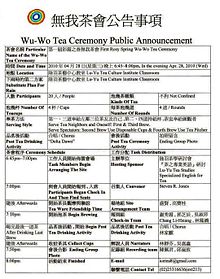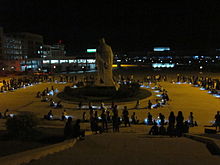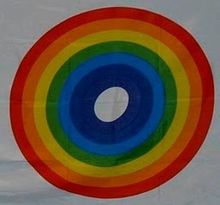- Wu-Wo tea ceremony
-
Wu-Wo Tea Ceremony 無我茶會, also known as Wu-Wo Tea Convention and Wuwo Tea Party. It is a style of Chinese tea ceremony that encourages participants to forget about knowledge, wealth, and appearance to establish a group equality without prejudice. This concept of Wu-Wo is shown in the Wu-Wo Tea Ceremony.
Wu-Wo tea ceremony Traditional Chinese 無我茶會 Simplified Chinese 无我茶会 Transcriptions Mandarin - Hanyu Pinyin wǔ wǒ chá huì . Min - Hokkien POJ bô-ngó͘ tê-hōe Contents
History
Wu-Wo Tea Ceremony began in Taiwan. Grand Master Tsai, Rong Tsang is the director of Lu-Yu Tea Culture Institute and the founder of the “Wu-Wo Tea Ceremony.” He has played an active part in the growth of this once small group from Taiwan (since 1991) into a now International Organization. Now Grand Master Tsai, Rong Tsang and Tea Arts Master Instructor Steven R. Jones [1] are writing in English to help expose people to the joys of tea and to further extend the Wu-Wo Tea Ceremony.
Basic tea ware
It can be any type of tea ware for any type of tea brewing/serving style, ex: Chinese, Japanese, Korean, British tea, and so on. It is usually a simple tea setting. A teapot, tea pitcher, thermos, the brewing mat can be a piece of cloth, the large setting mat can be a bath towel, the tea tray can be a kitchen plate, a the tea cloth in the middle between the pot and pitcher can be a paper towel, the time keeper can be a watch or timer.
What is needed:
- hot water in a thermos four times larger than your cover bowl or teapot
- teapot or cover bowl
- tea pitcher
- four teacups
- tea tray
- cloth wraps for tea ware and basket, backpack, or bag
- watch or timer for brewing
- small cloth
- mat or stool or cushion
- tarp, cloth, or towel to setup on
Basic brewing
This is a ceremony where everyone makes serves and drinks tea. as seating is decided by a random draw. no one knows beforehand who he will serve tea to or whose tea he will be served. Wu-Wo Tea Ceremony is a simple way to brew, serve, and drink tea, it can be done together or alone. The basic rules are simple; but occasionally subject to change:
We will make tea four times and we will make four servings each time.
- 1st brew, we pour into four cups and go serve to the adjacent three neighbors on the left (the last cup we reserve and enjoy our self), we will receive three cups of tea served from the adjacent three neighbors on the right.
- 2nd brew we pour into four spectator cups and this time serve four spectator and return and fill our own cup if any tea is left.
- 3rd brew we take the tea pitcher and go serve the same three tea brewers on the left with the tea pitcher.
- 4th and last brew we take the tea pitcher and serve any four spectators that do not have tea.
The special way of Wu-Wo Tea Ceremony and its Seven Principles 無我茶會特殊做法及其七大精神
- 1. Seating arrangement is chosen randomly. --- No priority to seats, no matter of social status. 座位由抽籤決定──無尊卑之分
- 2. Serving tea in the same direction. --- No reward is expected. 依同一方向奉茶──無報償之心
- 3. Accept and appreciate different teas. --- No bias. 接納、欣賞各種茶──無好惡之心
- 4. Brew the best you can. --- Concentrate and improve. 努力把茶泡好──求精進之心
- 5. No director. --- Everyone follows the public announcement. 無須指揮與司儀──遵守公共約定
- 6. Remain silent during brewing. --- To cooperate and appear in group rhythm and harmony. 泡茶席間不語──培養默契,體現團體律動之美
- 7. Not confined to any tea brewing manner. --- No distinction of school or region. 泡茶方式不拘──無流派與地域之分
Concept “Wu-Wo” (無我)
The Chinese word wuwo (simplified Chinese: 无我; traditional Chinese: 無我; pinyin: wúwǒ; Wade–Giles: wu-wo; Pe̍h-ōe-jī: bô-ngó; literally "without self") combines wu (無 "no; not; without; not have; there is not nothing") and wo (我 "I; me; my; we; our; self"). In Chinese Buddhist usage, wuwo translates Sanskrit anatta "no individual independent existence".[3]
Symbol
The flag for Wu-Wo Tea Ceremony is the circular rainbow flag. A "circular rainbow 圓形彩虹" is the symbol for the Wu-Wo Tea Ceremony. A rainbow is made of seven basic colors which, when combined together, become blank white light. The Wu-Wo Tea Ceremony pursues the circular rainbow and goes towards the blank light or empty circle in the flag's center. The blended white light or empty circle of the flag’s rainbow can be thought of as “wu”. The Wu-Wo Tea Ceremony follows this concept: for example, people have knowledge, wealth, and appearance, and try to forget these things and transcend.
Circular rainbow flag
The circular rainbow flag is a multi-colored flag consisting of rings in the colors of the rainbow. The actual colors shown differ, but many of the designs are based on the traditional scheme of red, orange, yellow, green, blue, indigo and violet, or some more modern division of the rainbow spectrum (often excluding indigo, and sometimes including cyan instead).
In depth
1. “Wu-Wo” is a style of tea ceremony. People bring simple tea ware and enjoy tea together in a circle. When there are many people, we can make two or more circles.
2. Seats are determined by drawing lots, to see who will sit next to each other and who will serve tea to one another, no one knows before. There will be no class distinction and everybody just accommodates oneself to the circumstances.
3. After setting up the tea ware, we can appreciate other’s tea ware, and get to know one another. This session is called “tea ware appreciation and friendship time”.
4. When it’s “brewing time”, everybody goes back to their seats to make tea. There is no director at a Wu-Wo Tea Ceremony; everything is based on the “public announcement”. The aim of this is to develop participants to follow some conventions.
5. After the first brew, participants take their cups to serve the tea. If, the “public announcement” states to “make four cups of tea, serve the three participants on the adjacent left and keep one teacup for oneself”, please follow the public announcement. At a Wu-Wo Tea Ceremony, tea is served in one direction, with the aim of to let participants serve without waiting for compensation; this is part of the Wu-Wo principles “no reward is expected".
6. If the recipient is sitting when you serve tea to him, please bow to one another without speaking. Participants remain silent at a Wu-Wo Tea Ceremony, when the brewing begins. This will give the appearance of group rhythm.
7. One may begin to enjoy the tea when one has received all. All participants must prepare the tea by themselves; therefore, everyone may have the chance to taste different kinds of tea and appreciates the different teas, this is the “no bias” principle of tea ceremony. When a cup is unpleasant, still accept it, as a reminder to brew good tea, this is the “concentrate and improve” principle of tea ceremony.
8. Start brewing the second brew when everybody has finished the first round. Pour the second brew into four disposable cups and serve four spectators then return to your seat. For the third brew, pour tea into the tea pitcher and pour in the same cups from the first brew; then return to your seat and give yourself some tea.
9. If it is in a public place, you can arrange a narrator to tell the public who are watching in order to let them understand what is going on. Also there can be an arrangement to serve the public for the second brew using disposable cups and forth brew using disposable cups or serving by pitcher.
10. There is no restriction on the tea ware and the brewing methods. However, to make good tea for everybody is the basic principle. Therefore, Wu-Wo Tea Ceremony is a style of tea ceremony with “no distinction of school or region”.
11. Setting up on the ground is for convenience. There are not any seats that would separate us. But there are no definite restrictions on sitting; one can even bring a small seat.
12. The tea ceremony can be held in the evening. Participants should bring themselves a personal light. An evening tea ceremony is an occasion for people to appreciate the beauty of the evening.
13. After the last cup, we can arrange some music or mediation for about 3 to 5 minutes. This is an opportunity to recollect on the tea ceremony, this session is called the “post tea drinking activity”.
14. “Post tea drinking activity” then, everybody should clean the cups and collect back one’s own cups. After everything is packed, the tea ceremony is over.
15. Wu-Wo Tea Ceremony reminds people of the significance of “emptiness”. Nothingness is not what we are pursuing, but the “having” then “emptiness”. Just like pure light which is formed by all the colors of the rainbow.
16. Wu-Wo Tea Ceremony began in Taiwan in 1990. It shortly became an international tea cultural activity. And, a large International Wu-Wo Tea Ceremony is held every two years in one country or region.
17. To promote Wu-Wo Tea Ceremony, the International Wu-Wo Tea Ceremony Association recruits “Tea Instructors” and “Tea Ceremony Instructors” and establishes “Tea Ceremony Classrooms” to promote tea arts and tea ceremony and provide training for participants of Wu-Wo Tea Ceremony through a 3-level education program.
International Wu-Wo Tea Ceremony Chronicle ( 歷屆國際無我茶會舉辦日期與地點 )
First conducted in Taipei, Taiwan on Dec. 18, 1990 第一屆 1990.12.18 台北市
2. Wuyi Mountain, Fujian, Oct. 17, 1991 第二屆 1991.10.17 福建省武夷山
3. Kyoto, Japan, Nov. 09, 1992 第三屆 1992.11.09 日本京都
4. Seoul and Iksan, Korea, Oct. 13, 1993 第四屆 1993.10.13 韓國首爾 益山
5. Wuyi Mountain, Fujian, Oct. 27, 1995 第五屆 1995.10.27 福建省武夷山
6. Taipei, Taiwan, Nov. 22, 1997 第六屆 1997.11.22 台北市
7. Hangzhou, Zhejiang, Oct. 16, 1999 第七屆 1999.10.16 浙江省杭州市
8. Shizuoka, Japan, Oct. 07, 2001 第八屆 2001.10.07 日本靜岡
9. Singapore, Aug. 23, 2003 第九屆 2003.08.23 新加坡
10. Wuyi Mountain, Fujian Nov. 03, 2005 第十屆 2005.11.03 武夷山
11. Seoul and Iksan, Korea, Oct. 12, 2007 第十一屆 2007.10.12 韓國首爾 益山
12. San Francisco, America,Oct.16~19,2009 第十一二屆2009.10.16~19 美國舊金山舉行
13. Taipei and Sun Moon Lake, Taiwan, May 27~Jun. 1, 2011 第十一三屆 2011.05.27~06.01 台北市, 日月潭
14. Korea, Summer 2013(scheduled) 第十四屆 2013夏天 韓國
Maple Fall Wu-Wo Tea Ceremony
Maple Fall Wu-Wo Tea Ceremony 枫林之夜无我茶会 Original name of "First Autumn Maple Forest Wu-Wo Tea Ceremony", now as of 2009 called "Maple Fall Wu-Wo Tea Ceremony", the tea ceremony is in Chinese and English.[5][6]
1. Lu-Yu Square, Tenfu Tea College, Nov. 16, 2008 7:00-7:45pm 第一屆 2008.11.16 日晚上地点天福茶学院陆羽广场
2. Teaching Building, Tenfu Tea College, Nov. 22, 2009 7:00-7:45pm 第二屆 2009.11.22 日晚上地点天福茶学院教学楼一楼回廊
3. Lu-Yu Square, Tenfu Tea College, Oct. 24, 2010 7:00-7:45pm 第三屆 2010.10.24 日晚上地点天福茶学院陆羽广场
Rosy Spring Wu-Wo Tea Ceremony
Held at Lu-Yu Tea Culture Institute in Taipei the "Rosy Spring Wu-Wo Tea Ceremony彩霞之春無我茶會" is in Chinese and English. This is also used in preparation for international Wu-Wo Tea Ceremonies, 2011 Taipei International Wu-Wo Tea Ceremony.
1. Lu-Yu Tea Culture Institute Classroom, Taipei, Apr. 28, 2010, 7:10-8:00pm 第一屆 2010.04.28 日晚上地點陸羽茶藝中心教室
2. Lu-Yu Tea Culture Institute Classroom, Taipei, Mar. 9, 2011, 7:10-8:00pm 第二屆 2011.03.09 日晚上地點陸羽茶藝中心教室
Tea Power Wu-Wo Tea Ceremony
Held at the Tenfu Tea College, the "Tea Power Wu-Wo Tea Ceremony茶动力无我茶会" is conducted by the international trainees in English. [7][8]
1. Lu-Yu Square, Tenfu Tea College, Dec. 2, 2010, 8:00pm 第一屆 2010.12.2 日晚上地点天福茶学院陆羽广场
See also
- Tea Appreciation Day
- Tea
- Tea Ceremony
- Taiwanese Tea Ceremony
- Perennial Tea Ceremony
- Gongfu Tea Ceremony
- Tenfu Tea College
- Lu-Yu Tea Culture Institute
References
- ^ Steven R. Jones
- ^ References: 書名 : 無我茶會180條作者 : 蔡榮章中華國際無我茶會推廣協會出版年 : 1999 The book is written in Chinese, Grand Tea MasterTsai, Rong Tsang and Tea Arts Master Instructor Steven R. Jones translated the English equivalent of the reference information. ( Title: Wu-Wo Tea Ceremony, 180 Steps Author: Tsai, Rong-Tsang International Wu-Wo Tea Ceremony Association Published: 1999 ) Grand Master Tsai Rong Tsang, (蔡榮章), is also the Director of the Department of Tea Culture, Tenfu Tea College
- ^ DeFrancis, John, 2003, ABC Chinese-English Comprehensive Dictionary, University of Hawaii Press.
- ^ International Wu-Wo Tea Ceremony(revised 2010.8)
- ^ 枫林之夜无我茶会
- ^ Maple Fall Wu-Wo Tea Ceremony
- ^ Tea Power Chinese ref.
- ^ Tea Power English ref.
External links
- Official Wu-Wo Tea Ceremony (無我茶會) (Chinese (Taiwan))
- Lu-Yu Tea Culture Institute 陸羽茶藝中心
- Tenfu Tea College 天福茶學院
- Tea Arts, Wu-Wo Tea Ceremony, English Site
- Tea Culture Monthly, Lu-Yu Tea Culture Institute(茶藝月刊, 陸羽茶藝中心工作報告)
- SPEECH BY MR HAWAZI DAIPI, SENIOR PARLIAMENTARY SECRETARY
- Flagstaff House Museum of Tea Ware, Hong Kong Museum of Art
Categories:- Articles with Chinese (Taiwan) language external links
- Tea ceremony
Wikimedia Foundation. 2010.



